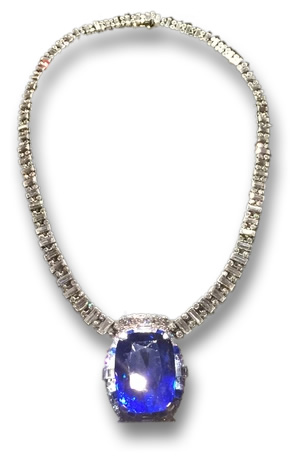Famous Jewelry: The Bismarck Sapphire Necklace

Introduction to the Bismarck Sapphire Necklace
The Bismarck Sapphire Necklace stands out as one of the most renowned gemstone jewelry pieces in modern history. Its former owner, Countess Mona von Bismarck (1897-1983), donated this priceless item to the Smithsonian Institution's National Museum of Natural History in 1967. In recognition of her generous gift, the Smithsonian named the striking sapphire and platinum necklace after her, calling it "the Bismarck Sapphire Necklace."
Mona von Bismarck: The Iconic Owner
Mona von Bismarck was a prosperous American fashion figure, celebrated worldwide as a true socialite known for her striking appearance. She appeared in Vanity Fair and Vogue magazines countless times. Beyond that, she starred in popular films and served as the muse for paintings by leading artists of her era. Throughout her eventful life, Mona married several notable figures, including Henry J. Schlesinger, James Irving Bush (once deemed the handsomest man in America), Harrison Williams (regarded as the richest man in America), Count Eddy von Bismarck (grandson of German Chancellor Otto von Bismarck), and nobleman Umberto de Martini. You can imagine the kind of life she led—full of glamour and high society.

Design and Features of the Necklace
The Bismarck Sapphire Necklace showcases a remarkable 98.6-carat cornflower-blue sapphire from Sri Lanka (once known as Ceylon). This cushion-cut gem sits in a platinum pendant encircled by white baguette diamonds and smaller square-cut blue sapphires. Crafted in 1935 by the prestigious jewelry house Cartier Inc., the pendant dangles from a chain of platinum links interspersed with round, brilliant, and baguette-cut diamonds. Altogether, the necklace includes 312 natural white diamonds and 9 blue sapphires, all boasting superior cut, clarity, and color.
The Bismarck Sapphire: Origin and Details
The central gem, dubbed the 'Bismarck Sapphire,' is thought to have been obtained in Sri Lanka by American tycoon Harrison Williams, who made his fortune in utilities. In 1926, during their honeymoon cruise, Harrison gifted the sapphire to Countess Mona von Bismarck, along with other extravagant presents. At that period, Sri Lanka was under British control and actively sourced high-quality gems from the Ratnapura district.
The Ratnapura area in Sri Lanka boasts a rich legacy, supplying fine rubies and sapphires since the era of King Solomon in the 10th century BC. Even now, this river basin continues to yield many of the premium sapphires available today. Considering the traditional cutting methods of Sri Lankan gem artisans in 1926, experts believe the original stone exceeded 98.6 carats before Cartier recut it. Local cutters prioritized retaining carat weight, but the recut version achieved ideal proportions, vivid color, and masterful workmanship. For more details on sapphires, check out our Sapphire Gemstone Information.
Historical Significance and Art Deco Influence
The Bismarck Sapphire Necklace is recognized as a key influence in Art Deco jewelry design. It played a role in shaping the cleaner, more streamlined aesthetic of Art Deco, which flourished between 1920 and 1935. Prior to this, jewelry tended toward more ornate and traditional styles, like those in Art Nouveau. If you're into jewelry history, this piece really marks a shift in tastes.

Display at the Smithsonian
Since 2010, the Bismarck Sapphire Necklace has been exhibited in the Janet Annenberg Hooker Hall of Geology, Gems and Minerals at the Smithsonian. It resides between the well-known "Hall Sapphire and Diamond Necklace" and the "Logan Sapphire." Without a doubt, it ranks among the standout gemstone jewelry items in the Smithsonian's impressive gems collection. Another iconic piece worth exploring is the Heart of the Ocean Necklace.
Frequently Asked Questions
Who was Mona von Bismarck?
Mona von Bismarck was an American fashion icon and socialite, famous for her beauty and featured in magazines like Vanity Fair and Vogue. She married several prominent men and donated the necklace to the Smithsonian.
What materials make up the Bismarck Sapphire Necklace?
The necklace features a 98.6-carat cornflower-blue sapphire as the centerpiece, set in platinum with 312 white diamonds and 9 blue sapphires.
Where did the Bismarck Sapphire originate?
The sapphire came from Sri Lanka, specifically the Ratnapura district, known for producing high-quality gems for centuries.
Who designed the Bismarck Sapphire Necklace?
The necklace was designed by Cartier Inc. in 1935.
Where can I see the Bismarck Sapphire Necklace today?
It is on display at the Smithsonian Institution's National Museum of Natural History in the Janet Annenberg Hooker Hall of Geology, Gems and Minerals.

